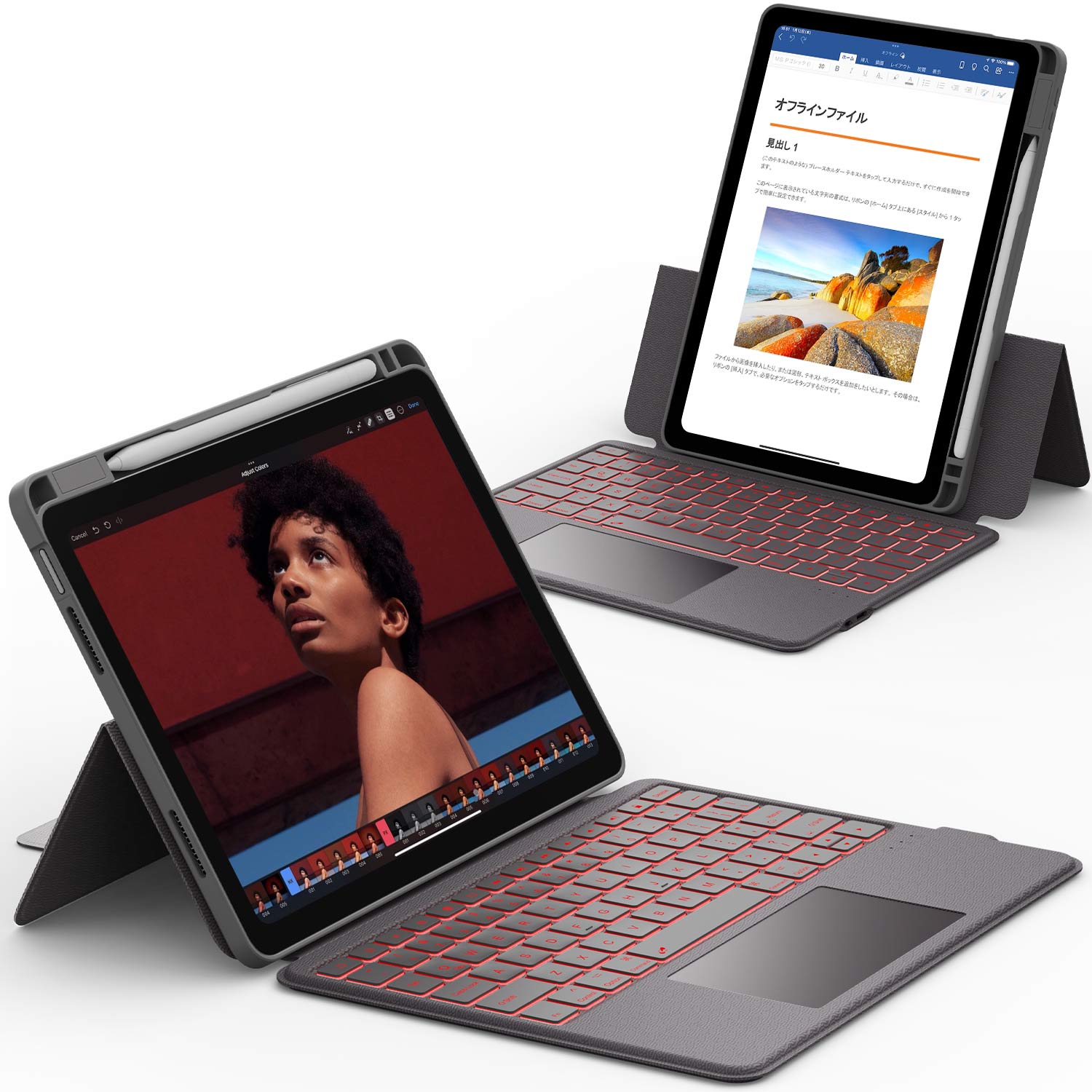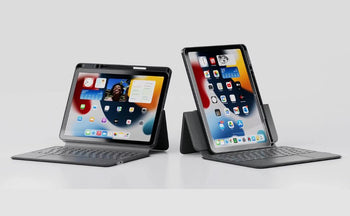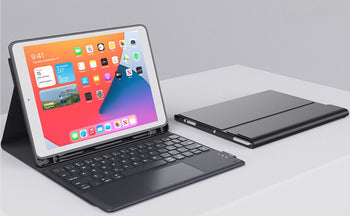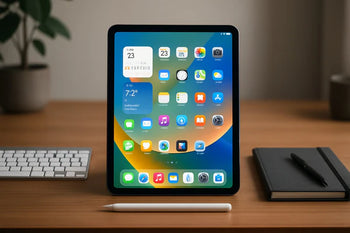Picking between the iPad Pro and Surface Pro isn’t easy. Both look sharp, pack a punch, and travel well.
Apple’s M4 iPad Pro runs fast and has a gorgeous screen. Microsoft’s Surface Pro works as a flexible 2-in-1—honestly, it feels more like a laptop than a tablet sometimes.
If you want a tablet that fits your workflow—whether creative, professional, or everyday use—the right choice depends on how you plan to use it.
You’ll spot differences in design, display, and speed right away. The iPad Pro keeps things simple with iPadOS, while the Surface Pro brings the full Windows experience with more software freedom.
Each one shines in its own way—digital art, multitasking, or just getting things done.
Check out our iPad Pro - 12.9" Cases (6th/5th/4th/3rd Gen) for large-screen professionals.
Key Differences Between iPad Pro and Surface Pro

The iPad Pro and Surface Pro might look similar, but they work differently. Their software, accessories, and pricing all shape the way you’ll actually use them.
Device Philosophy and Ecosystem
The iPad Pro runs iPadOS, focusing on touch, apps, and Apple’s ecosystem. You get the App Store, iCloud, and tools made for creativity and mobility.
It feels like a tablet first, but with the Magic Keyboard, it handles some laptop jobs.
On the other hand, the Surface Pro uses Windows 11, so you get a true desktop experience. You can install regular software, plug in external drives, and use several windows at once.
Microsoft lets you swap out the SSD and use a bunch of accessories, which is pretty handy.
If you already use Apple stuff, the iPad Pro slides right in. But if you like Windows or need desktop apps, Surface Pro just gives you more room to work your way.
Target Users and Use Cases
The iPad Pro really fits creative folks, students, and anyone who’s always on the move. The M4 chip and Ultra Retina XDR display make it awesome for editing photos, drawing, or even just binging videos.
The Apple Pencil Pro adds that extra bit of precision for sketches and notes.
The Surface Pro, especially with the new Snapdragon X Elite chips, is best for people who need a full PC. You can run Photoshop, Excel, or whatever desktop app you want—no weird workarounds.
The built-in kickstand and Surface Flex Keyboard are great for business or heavy multitasking.
If your workflow relies on iPad apps and cloud syncing, the iPad Pro feels fast and easy. Need old-school desktop tools or more ports? The Surface Pro has your back.
Pricing and Value
Prices change depending on what you pick and what extras you want. The 13-inch iPad Pro starts at about $1,299 for 256GB. The Surface Pro is around $1,499 for a similar setup.
The iPad Pro’s Magic Keyboard and Pencil Pro cost extra. Surface accessories, like the Surface Keyboard with Slim Pen, aren’t included either.
|
Model |
Starting Price |
Max RAM |
Max Storage |
Cellular Option |
|
iPad Pro (M4) |
$1,299 |
16GB |
2TB |
Yes |
|
Surface Pro (Snapdragon X Elite) |
$1,499 |
32GB |
1TB |
Coming soon |
Apple charges more for its display and build, but Microsoft gives you better upgrade options and a removable SSD. Tom’s Guide says both are powerful—it really comes down to whether you want a tablet-first or laptop-first device.
Browse our iPad Cases With Stand for comfort and convenience during work or entertainment.
Design and Build Quality

Both devices look sleek, feel sturdy, and travel well. But they each have their own vibe when it comes to materials, size, and how they fit into your day.
Materials and Color Options
The iPad Pro uses a single aluminum piece with flat edges and a soft finish. It’s simple, feels fancy, and matches Apple’s usual style.
You can pick Silver or Space Black. Both resist fingerprints and scratches pretty well.
The Surface Pro goes with magnesium alloy, which feels solid and cool. You’ll usually see it in Platinum, Graphite, and sometimes Sapphire or Forest.
The matte finish cuts down glare and smudges.
Both show great build quality, but they aim for different things. The iPad Pro is light and refined. The Surface Pro feels tougher and more business-like.
If you want something elegant and minimal, go iPad Pro. Prefer a rugged, professional look? Surface Pro is probably more your speed.
Portability and Form Factor
The iPad Pro is super thin—about 5.1 mm on the M4 model. You can hold it in one hand or toss it in a small bag without thinking about it.
The smooth edges and balanced weight make it comfy for long stretches, whether you’re drawing or reading.
The Surface Pro is a bit thicker and heavier. But it makes up for it with a 13-inch PixelSense Flow display that runs at 120Hz.
You get a bigger screen for multitasking, though it’s a little bulkier to carry.
If you care most about portability, the iPad Pro is easier to carry. If you want a bigger display and more of a desktop feel, Surface Pro wins—even if it weighs a bit more.
Kickstand vs. Tablet-Only Design
The Surface Pro has a built-in kickstand. You can adjust the angle for typing, drawing, or just watching something. It stays put, even if your desk isn’t flat.
The Surface Connect port lets you dock it easily with monitors and accessories.
The iPad Pro doesn’t have a stand built in. You’ll need the Magic Keyboard or another case to prop it up, which keeps the tablet slim but means more stuff to buy.
If you work at a desk or give presentations, the Surface Pro’s kickstand is just easier. Want a simple, clean tablet? The iPad Pro keeps things uncluttered.
Display Technology and Experience
The screens are where these tablets really split. The iPad Pro uses OLED for deep blacks and punchy color. Surface Pro sticks with LCD-based PixelSense Flow for smooth motion and sharp detail.
Both aim for crisp, bright, and responsive displays—great for art, editing, or just browsing.
Screen Size and Resolution
The iPad Pro M4 comes in 11-inch and 13-inch sizes. Resolutions go up to 2420 × 1668 and 2752 × 2064.
The OLED panel gives you deep blacks and strong contrast—photos and videos just pop.
The Surface Pro 12 uses a 12-inch PixelSense Flow LCD with 2196 × 1464 resolution. It’s sharp, but doesn’t quite match OLED’s contrast.
If you want a bigger canvas, Surface Pro feels roomier. But if you need every pixel for editing or design, iPad Pro’s higher density is tough to beat.
|
Device |
Display Type |
Resolution |
Size |
|
iPad Pro M4 |
OLED |
2420×1668 / 2752×2064 |
11" / 13" |
|
Surface Pro 12 |
LCD (PixelSense Flow) |
2196×1464 |
12" |
120Hz Dynamic Refresh Rate vs. ProMotion
Both support 120Hz refresh rates, but they handle it their own way. The iPad Pro uses ProMotion, which shifts between 10Hz and 120Hz depending on your activity.
This saves battery when you’re not moving much, but stays smooth when you are.
Surface Pro 12’s 120Hz Dynamic Refresh Rate keeps things smooth too, but isn’t quite as adaptive. It’s still great for drawing or scrolling, with barely any lag.
Honestly, the iPad Pro feels a bit more fluid, but Surface Pro holds up well for writing or sketching.
Brightness and Color Accuracy
The iPad Pro’s OLED can hit around 1000 nits peak brightness. That makes it easy to see in bright spaces or outside.
It supports the wide P3 color gamut, which is awesome for photo editing or watching HDR videos.
The Surface Pro 12 is bright enough for indoors but doesn’t do HDR. Its LCD shows natural colors, though blacks aren’t as deep as OLED.
If you want top-notch color and contrast, the iPad Pro is the way to go. Surface Pro still looks good for reading, note-taking, and general work.
Also read our article on the Best iPad Accessories Every iPad Owner Needs to complete your setup.
Performance and Hardware
CHESONA ArmorDock Series Keyboard Case for iPad Pro 12.9" 6/5/4/3th
These two chase top performance in small packages. Apple’s iPad Pro is all about efficiency and smooth integration, while Microsoft’s Surface Pro leans into flexibility and bigger memory options.
Processor and Chipset Comparison
The M4 chip in the iPad Pro is Apple’s latest processor. It follows the M1, M2, and M3 chips used in earlier models.
Apple built it on a 3‑nanometer process. You get up to 10 CPU cores and a 10‑core GPU.
Everyday tasks and creative apps feel snappier, especially with faster single‑core performance. It’s honestly hard to slow this thing down.
Microsoft’s Surface Pro uses the Qualcomm Snapdragon X Elite chip. This one’s built on a 4‑nanometer process and packs 12 CPU cores.
The Snapdragon chip does well with multi‑core workloads and sips power efficiently. Even though it has more cores, Apple’s chip usually wins on performance per core, thanks to how tightly Apple controls both hardware and software.
|
Feature |
iPad Pro (M4) |
Surface Pro (Snapdragon X Elite) |
|
Process |
3nm |
4nm |
|
CPU Cores |
9 or 10 |
12 |
|
GPU Cores |
10 |
12 |
|
Single‑Core Score |
~3700 |
~2400 |
|
Multi‑Core Score |
~14000 |
~14000 |
RAM and Storage Options
You can pick 8GB or 16GB of RAM on the iPad Pro, depending on which storage size you choose. Storage ranges from 256GB to 2TB.
You can’t upgrade the memory, but Apple tunes iPadOS so you get steady performance even with less RAM. It’s a locked-in system, but it works smoothly.
Surface Pro starts you at 16GB or 32GB of RAM and comes with 512GB to 1TB of removable SSD storage. You can swap out the drive later, which is handy if you need more space down the road.
If you juggle big files or run lots of apps at once, that extra memory and the upgrade path are a real bonus.
|
Feature |
iPad Pro |
Surface Pro |
|
RAM |
8GB / 16GB |
16GB / 32GB |
|
Storage |
256GB–2TB |
512GB–1TB (removable) |
AI and Machine Learning Capabilities
Both devices use built‑in neural processors for AI and machine learning tasks. The M4 chip has a 16‑core Neural Engine that can handle up to 38 trillion operations per second.
This helps speed up photo edits, language features, and real‑time effects in creative apps. It all happens in the background, but you’ll feel it when things just work faster.
The Surface Pro’s Qualcomm Hexagon NPU can push about 45 trillion operations per second. That’s more raw AI horsepower on paper.
Windows uses this for stuff like live captions, background blur, and voice focus. Apple’s numbers are lower, but their hardware and software work together tightly, so you get smooth results without fiddling with settings.
Check Best Android Tablet for Kids for Learning & Play for insights into cross-platform versatility.
Software and User Experience
CHESONA Cloud Series Keyboard Case for iPad Pro 13'' (M4) 2024
Both tablets run fast and smooth, but their styles couldn’t be more different. Apple keeps things simple and organized, while Microsoft wants to give you a full desktop with all the options.
iPadOS vs. Windows 11
iPadOS 17.5 feels clean and straightforward. It’s all about touch, gestures, and Apple’s app ecosystem.
You can zip between apps, use widgets, and try features like Stage Manager for multitasking. If you already use Apple stuff, the interface feels familiar across iPhone and Mac.
Windows 11 gives you a classic desktop layout. Open lots of windows, drag files, and use a mouse or keyboard just like on a laptop.
It also brings in Copilot, Microsoft’s AI helper, for quick tips and smart suggestions. If you like that old-school PC feeling, this is where you’ll feel at home.
|
Feature |
iPadOS 17.5 |
Windows 11 |
|
Input |
Touch, Pencil, Keyboard |
Touch, Keyboard, Mouse |
|
Interface |
Simplified, mobile-first |
Desktop-style |
|
AI Tools |
Siri, Neural Engine |
Copilot, AI features |
If you want a touch-first, easygoing experience, iPadOS just feels right. If you need full PC control, Windows 11 is the obvious pick.
Multitasking and Productivity
On iPad Pro, multitasking uses Stage Manager and Split View. You can run a couple of apps side by side, resize windows, or hook up an external display for more space.
It’s smooth, but honestly, it’s not as flexible as a full computer. Surface Pro 11 runs Windows 11, so you get classic multitasking.
Open as many apps as you want, drag and drop between them, and use heavy desktop programs like Microsoft Office or Adobe Photoshop. If you’re always switching between complex files or lots of apps, Surface Pro gives you more freedom.
But if you just want to focus on one or two things at a time, iPad’s simpler setup helps you avoid distractions.
App Availability and Compatibility
iPadOS has a huge library of apps made for touch. Creative tools like Procreate, LumaFusion, and Affinity Photo run great, especially with the Apple Pencil.
You can’t install full desktop apps, though. Windows 11 supports both desktop and Microsoft Store apps.
You can install old-school programs, run web apps, or even use Android apps from Amazon’s Appstore. For professional or technical work, that’s a big plus.
If you rely on special Windows software, Surface Pro is the safer pick. But if you’d rather have well-designed touch apps and a clean experience, iPad Pro is just more fun to use.
Also discover our iPad Pro M4 case collection for premium design and protection.
Connectivity and Ports
Both tablets connect to fast networks and lots of accessories. The differences show up in wireless standards, port choices, and how each handles power and expansion.
It might sound boring, but these details matter if you need to plug in displays, move files, or stay online without hassle.
Wi-Fi 6 and Wi-Fi 6E Support
The iPad Pro comes with Wi‑Fi 6. That’s plenty fast for streaming, cloud backups, and online calls at home or work.
Surface Pro 9 and newer step up to Wi‑Fi 6E. If your router supports it, you get access to the 6 GHz band, which means less interference and even faster speeds.
Wi‑Fi 6E is nice if you work in crowded places where networks get bogged down. Both tablets have Bluetooth 5 or newer, so connecting keyboards, headphones, or styluses is easy and lag-free.
|
Feature |
iPad Pro |
Surface Pro (9/11) |
|
Wi‑Fi Standard |
Wi‑Fi 6 |
Wi‑Fi 6E |
|
Bluetooth |
5.0 |
5.1 – 5.4 |
|
Cellular Option |
5G (optional) |
5G (select models) |
USB-C and Thunderbolt 4
The iPad Pro gives you a single USB‑C/Thunderbolt 4 port. It handles charging, external displays up to 6K, and fast data transfers.
You can add hubs or docks, but with just one port, you’ll need adapters if you want to charge and plug in accessories at the same time.
The Surface Pro 9 and Surface Pro 11 have two USB‑C ports supporting USB4/Thunderbolt 4. That makes life easier if you multitask—charge with one, use the other for a monitor or external drive.
Both support DisplayPort over USB‑C, but Surface’s extra port gives you more breathing room for accessories.
Surface Connect Port and Expansion
Microsoft adds a Surface Connect port for its magnetic charger and docking gear. That’s handy for keeping a USB‑C port open while you charge or add more ports with a dock.
The Surface Dock 2 and other accessories expand your setup with Ethernet, USB‑A, or extra display outputs. The magnetic cable pops off easily, so you don’t wear out the USB‑C connector.
Apple keeps things simpler. The iPad Pro just uses its USB‑C port and Smart Connector for things like the Magic Keyboard.
This keeps the design sleek, but you don’t get as many ways to expand as you do with Surface’s dedicated port system.
Explore Best iPad Pro Apps to Power Up Your Device for maximizing productivity on Apple’s side.
Security and Additional Features
Both tablets care about security, but they go about it in their own ways. iPad Pro locks down the system and checks every app, while Surface Pro leans into flexibility and business tools.
How you log in, store biometrics, and use extra features can feel pretty different.
Windows Hello and Face ID
Windows Hello on Surface Pro uses your face or fingerprint to unlock fast. It works with the front camera and infrared sensors, so it’s reliable in different lighting.
You can also set up a PIN or use a security key if you want. Face ID on the iPad Pro uses Apple’s TrueDepth camera system.
It scans your face with infrared dots, making a secure 3D map that works even in the dark or with glasses. Apple stores this data on the device, never in the cloud.
Both systems are fast and work well, but they serve different crowds. Windows Hello fits business logins and multiple users, while Face ID is built for privacy and personal use.
Biometric Authentication
Both tablets let you use biometrics to keep your stuff safe. The iPad Pro relies on the M4 chip’s Secure Enclave, which keeps your face data separate from everything else.
Apps can ask you to authenticate, but they never see your biometric info. Surface Pro stores biometric data with Windows Hello’s Trusted Platform Module (TPM).
This hardware encryption protects your credentials and works with Microsoft’s business tools like Azure Active Directory.
In real life, both are pretty secure. Apple’s system is closed off, so outside access is limited, while Microsoft’s open design lets businesses set things up their way.
If you use your tablet for work, Windows Hello gives you more sign-in choices. For personal use, Face ID’s hardware isolation feels super safe and needs almost no setup.
Special Features
Each tablet packs in some extra security and convenience tools. On the iPad Pro, you get Find My, App Tracking Transparency, and strict app permissions.
iPadOS runs every app in its own space, so malware can't spread easily. That sandboxing just works quietly in the background.
The Surface Pro brings BitLocker encryption, Windows Defender, and Secure Boot to the table. You can tweak security settings through Windows Security or enterprise tools if you want that level of control.
These Surface features give you more options, but honestly, they ask for a bit more hands-on work. So, if you like automatic privacy and security, the iPad Pro just handles it. But if you want to dig in, manage files, and connect with company systems, the Surface Pro lets you do all that.
Explore our iPad Pro 11 Inch Case With Keyboard collection for a laptop-like experience.
Battery Life and Real-World Usage
CHESONA Rugged Series Keyboard Case for iPad Pro 12.9'' & Air 13'' (M2/ M3)
You’ll spot real differences in battery life depending on what you do and how you use these tablets. Battery size, efficiency, and charging speed all matter more than you might expect.
Battery Capacity and Endurance
The M4 iPad Pro usually gives you about 10 hours of web browsing or video playback on Wi‑Fi. Expect around 9 hours if you’re on cellular.
Apple keeps that battery life steady, but the M4 chip squeezes out a bit more efficiency. The Surface Pro 11 claims up to 10 hours of web use and up to 14 hours of local video playback.
In real life, battery drops faster with heavy multitasking or tough apps. Here’s a quick comparison:
|
Device |
Rated Battery Life (Web) |
Rated Battery Life (Video) |
Battery Type |
|
iPad Pro (M4) |
Up to 10 hrs |
Up to 10 hrs |
38.8‑Wh lithium‑polymer |
|
Surface Pro 11 |
Up to 10 hrs |
Up to 14 hrs |
~50‑Wh lithium‑ion |
If you mostly watch offline video, the Surface hangs on a bit longer. For mixed online use, the iPad usually keeps up just fine.
Charging Options
You charge the iPad Pro with its USB‑C/Thunderbolt 4 port. Use a 20W or higher charger for fast charging.
With a 30W charger, you’ll hit about 50% in half an hour. The Surface Pro uses USB4/Type‑C ports and often supports 65W chargers.
Microsoft’s Surface Connect charger speeds things up even more. Both tablets work with third‑party USB‑C chargers.
The iPad’s smaller battery tops off quicker, but the Surface’s bigger battery means you can go longer once it’s full. It’s a bit of a trade-off, honestly.
Usage Scenarios
How you use these tablets changes battery life a lot. Simple stuff like note‑taking or streaming music barely drains either one.
If you edit photos or videos, the iPad’s M4 chip stays efficient but burns more power under stress. The Surface Pro’s Snapdragon X Elite handles lots of tasks, but the fans and bigger screen can eat up battery faster.
When you’re traveling or working away from a plug, you’ll usually get a full workday from either one. Lowering brightness, closing apps, and turning on battery saver can stretch your time away from an outlet.
Bottomline
The iPad Pro vs Surface Pro debate is all about versatility and power. Apple’s iPad Pro excels in creativity and portability, while Microsoft’s Surface Pro offers a laptop-like experience for productivity.
Both deliver premium performance — your choice depends on your workflow and ecosystem preference. No matter which you choose, protection and style are essential.
Explore CHESONA’s iPad cases and tablet cases to enhance your device’s durability and functionality. From magnetic keyboard cases to rugged designs, CHESONA ensures your tablet performs and looks its best every day.
Read our guide, Best Tablet for the Money: Value That Lasts, to see how both stack up in performance and price.
Frequently Asked Questions
What are the main differences in performance between the iPad Pro and the Surface Pro?
The iPad Pro runs on Apple’s M4 chip, which is super fast for single‑core stuff and saves power. It handles tough apps like photo and video editors without any fuss.
The Surface Pro uses Qualcomm’s Snapdragon X Elite chip. It’s solid for multitasking and Windows apps, but it lags just a little behind the M4 in single‑core speed. You can pick higher RAM if you need to run a bunch of heavy programs.
Can you compare the battery life of the iPad Pro and the Surface Pro?
The iPad Pro lasts up to about 10 hours for web or video on Wi‑Fi, and around 9 hours on cellular. The Surface Pro gives you about the same for web, but can stretch to 14 hours if you’re just watching offline video.
If you mostly watch downloaded movies, you’ll squeeze more time from the Surface. For mixed use, they’re pretty close.
How do the cameras of the iPad Pro and the Surface Pro stack up against each other?
The iPad Pro gives you a 12MP rear camera with LiDAR, and a 12MP front camera with Center Stage for video calls. Pictures look sharp and video is smooth.
The Surface Pro has a 10MP rear camera and an ultra‑wide front camera with auto framing. It’s great for meetings, but not as fancy for photos or AR stuff.
Which device offers better value for artists and designers?
If you draw or design, the iPad Pro with Apple Pencil Pro feels smoother. You get low latency, pressure sensitivity, and a bright OLED screen with wide colors.
The Surface Pro and Slim Pen 2 also support pressure and tilt. Windows drawing apps feel more like desktop tools, so you might like it better for Adobe or 3D modeling.
What are the pros and cons of the operating systems in the iPad Pro and Surface Pro?
iPadOS is simple, secure, and built for touch. It runs mobile apps that open fast and sync easily with other Apple gear. Some desktop workflows just aren’t possible, though.
Windows 11 on the Surface Pro lets you run full desktop apps, manage files, and multitask however you want. It’s more complex, but you get more control and compatibility.
How do the keyboard and stylus accessories for the iPad Pro and Surface Pro compare?
The Magic Keyboard for iPad Pro feels sturdy. It has a big trackpad and backlit keys.
It snaps on magnetically and turns the tablet into a little laptop. I wish it was a bit lighter, but it gets the job done.
The Surface Flex Keyboard and Slim Pen work wirelessly. They come with a built-in battery, which is handy.
You can detach them for more freedom. They do cost more than Apple’s stuff, though, which makes me hesitate a bit.





















